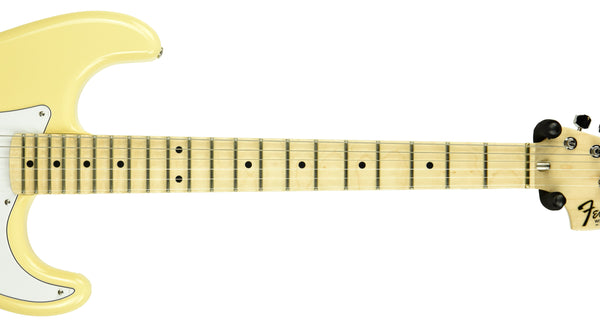There are plenty of terms in the Guitar World that warrant some explanation. This time around, we cover the Scalloped Fingerboard! A rarely seen odd-bird spec, popularized by Yngwie Malmsteen and Ritchie Blackmore. The scalloped board requires a different touch, typically much lighter than what the average player doles out. 
A Scalloped Fingerboard looks fairly different than a standard fretboard so it's pretty easy to see the differences. Take a gander, why don't ya?

Basically, the wood between each fret is scooped out (more like sanded) but it looks like you took an ice cream scoop perfectly sized to the distance between each fret, and scooped away that top layer. You are left with a very tall feeling fret that sits atop a hill, if you will. The fret itself let's you know when to stop applying pressure. Push any harder, and you are intonating sharp.
This detail makes playing chords rather difficult so we have found that a scalloped board is far better suited to the lead or melodic player that stays away from chords, ESPECIALLY bar chords!

Pros: Some find this makes a guitar play faster. For them, the notes seem to jump of the guitar with an incredibly fast and precise attack. Set these up with a 9 gauge string and you can barely even feel them! Bends are a breeze, vibrato has never been easier and you certainly can pull off some upward pitch bends that you can't do on a regular neck.
Cons: Playing chords in tune is considerably more difficult than on a regular fingerboard. It requires an incredibly deft fretting hand, even getting double stops in tune can prove tough. On a personal note, it feels really weird, most have agreed after experiencing.
Bottom Line: it's a fun novelty for any guitarist to experience but it really only makes sense for someone playing solo's or melodic content most of the time. A scalloped board shines some extra light on just what an amazing talent Yngwie Malmsteen is, as most who try to wield this mighty sword fail in their attempt!
This quick, hard-hitting expose of the scalloped fretboard was penned by Mathew Jenkins. He hates scallops on his plate and fingerboard.

Nicely written. The use of scalloped fretboards can also improve the technique and speed of execution on the fretboard, which I feel, due to the need to use a lighter and more precise touch on the strings to avoid off-tune sounds. I installed the Les Paul guitar bridge (https://faberusa.com/product-category/faber-bridges/abr-59/) last week on my piece, the sound blew my mind.
Chords are only an issue if you play on rubber bands and the scallop is deep low on the fretboard. With heavy strings there is no issue and the main thing you feel is a faster attack and easier fretting.